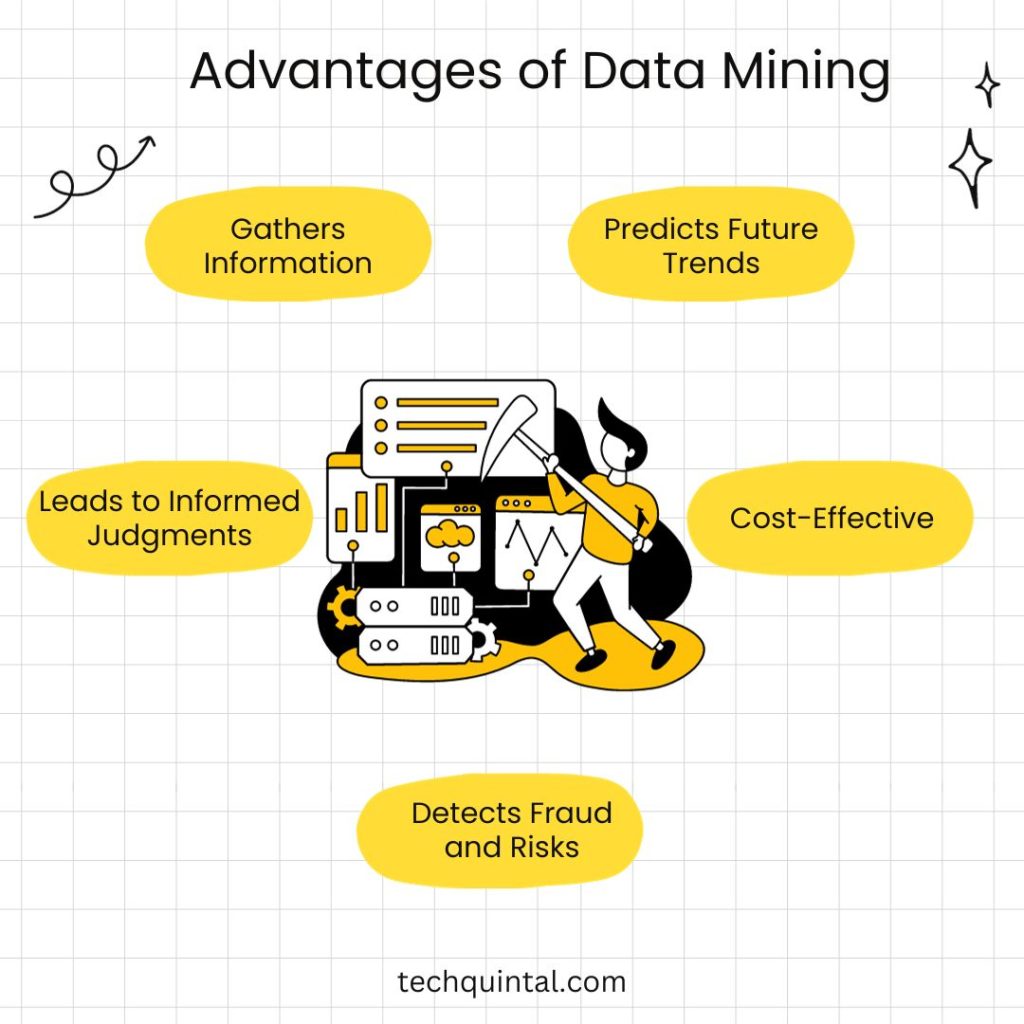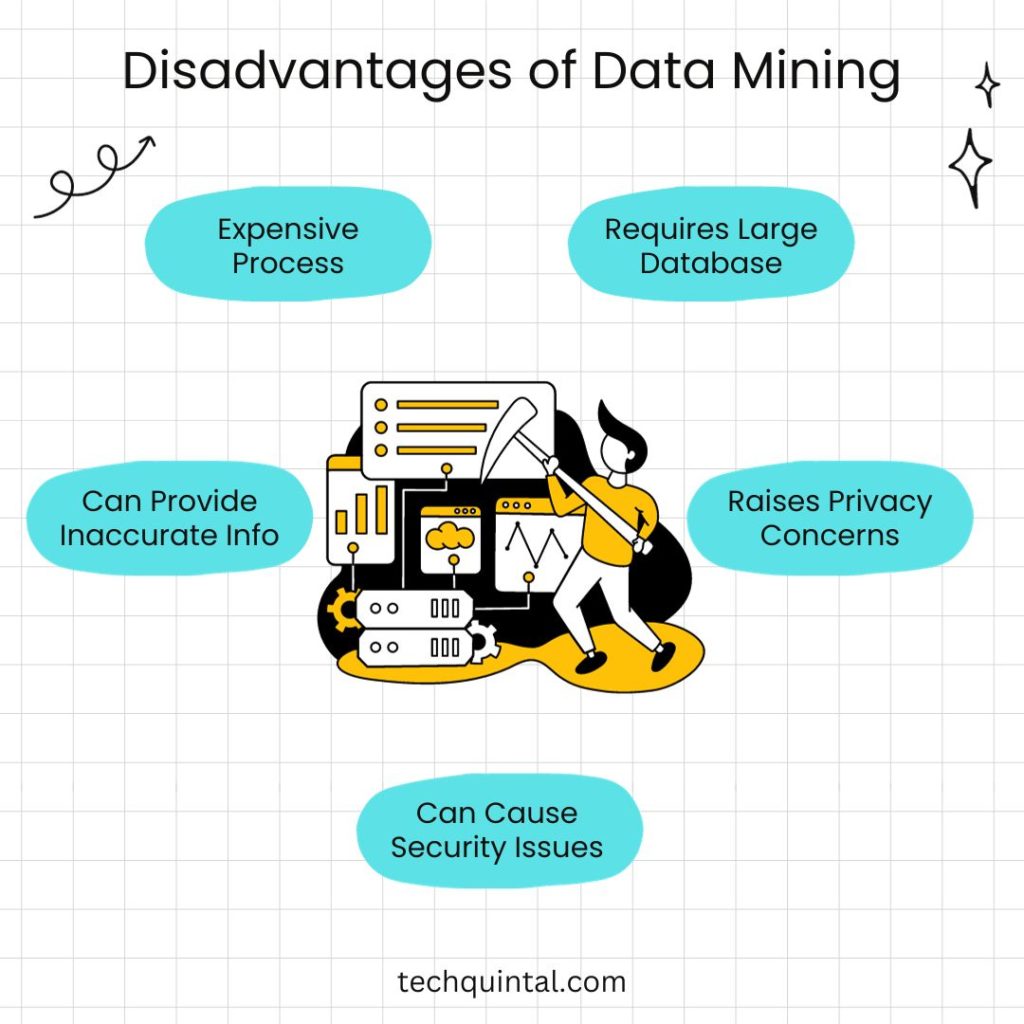
In the digital age we are living in, a huge volume of data is produced every year. In fact, unstructured data makes up 90% of it. That’s when we need processes such as data mining to identify patterns, trends, and relationships from the raw data to make sense of it. The concept of digging through data is not new, but the traditional method was manual, tedious, and time-consuming. With advancements in technology such as high computer processing power, big data, artificial intelligence, and machine learning, data mining evolved and gained popularity.
This approach has now become essential for businesses, letting them solve problems and find new opportunities. It helps them understand their customers and develop effective strategies.
It also allows them to make better and more informed decisions, all the while ensuring they meet their defined objectives. Now that we have covered a concise summary of data mining, let’s move on to understanding its advantages and disadvantages.
What is data mining?
Data mining is the process of discovering patterns, correlations, and anomalies within large sets of data that are too complex or voluminous to analyze by traditional methods. It utilizes a variety of techniques in order to extract valuable insights from often unstructured or raw data. The techniques include machine learning, artificial intelligence, and statistical analysis.
These extracted insights can then be used for decision-making, forecasting trends, or understanding complex phenomena. Data mining plays an integral role in many sectors we utilize today; from businesses predicting customer behavior to healthcare professionals diagnosing diseases.
Advantages of data mining

Data mining is crucial for businesses as their success depends on it. This is to say they need it to discover insights from the data and make educated decisions. The following are some benefits of data mining.
1. Data mining helps in gathering information
Businesses use data mining to analyze the massive data available to them. It lets them comprehend what is working for them and what needs to be improved. The real-time data analysis allows them to examine various trends including purchasing patterns based on demographics.
With this valuable information gathering, businesses can create products or services that can then sell themselves. Along with this, data mining is used to improve customer retention, eventually reducing churn.
2. It predicts future trends
Businesses use data mining to analyze historical and current data. This allows them to generate a model that helps in predicting future outcomes. For instance, marketing and sales professionals capture and analyze several types of customer data related to their products and purchasing preferences.
It gives them insights into the future buying behaviors of customers. The predictions are useful in planning demand and supply actions, therefore making the business more profitable.
3. It aids in making informed judgments
With data mining, businesses find meaningful relationships among data. This helps them immensely in making business decisions. Also, before mining the data, the purpose should be specified as it makes it easier to discover hidden relationships.
Additionally, there are several data mining techniques that generate insights for developing strategies. Here are three:
- Clustering technique is used to make informed decisions based on customer behaviors and demographics.
- Data visualization technique is utilized to represent data visually, making it easier to understand and interpret, therefore promoting quick and informed decision-making.
- Data warehousing technique is employed to derive insights for improving decision-making that gives businesses a competitive edge in the market.
4. Data mining is cost-effective
When compared to other data-oriented applications, data mining is cost-efficient. Also, it assists users in predicting future demands. That way, the cost of the operation is reduced as businesses can develop accurate inventory forecasts and accordingly purchase supplies.
Ultimately, it eliminates unnecessary spending. Additionally, with data mining, businesses can improve the allocation of critical resources such as equipment, material, and labor substantially. Consequently, optimizing resource allocations reduces cost.
5. It detects fraud and risks
In the banking sector, data mining makes predicting loan payments and credit reporting more manageable. It helps in tracking spending habits for the detection of fraudulent transactions.
Moreover, it allows organizing data in a way that helps to uncover patterns that are otherwise difficult to find with traditional means. In other words, data mining makes risks and fraud more detectable.
Disadvantages of data mining

Just like any other process, data mining is not perfect. The following are some of its disadvantages.
1. Data mining is expensive
Undoubtedly data mining helps businesses to understand their customer, predict their behavior, and accordingly plan actions. However, the process of mining data is expensive. For efficient mining, the data should be collected from multiple sources. There are costs associated with the collection, especially when the data is unavailable, as it needs to be purchased.
Furthermore, there are hardware and software costs associated with the process. Implementing and maintaining its infrastructure is costly, too. Then, the licensing fees of the necessary software add up to the expenditure. Along with this, businesses need to hire technology specialists or provide training to the employees, making the entire process pricey.
2. It needs a large database
For data mining to be effective, it requires a considerable database. The reason is the small database limits the process of extracting valuable information. With a large database, more information is available to analyze trends and make data mining successful.
3. It raises privacy concerns
With data mining, businesses can track their customers purchasing habits and transactions. If the data is solely used for improving the customer experience then they rarely have a problem. But that’s not the case, in today’s time, people are worried about their data being sold to third parties without their knowledge. This increases unease about individual privacy.
4. Data mining can provide inaccurate information
Just like the saying, you reap what you sow, the information you receive from data mining depends on the one you analyze. This means if the dataset is inaccurate or of poor quality, then the information provided to you may be inaccurate too.
Businesses will have to face massive consequences if incorrect information is applied to decision-making. Moreover, if there are mistakes in pre-processing the results will be wrong findings.
5. It can cause security issues
Even though with legitimate data mining, the information is kept anonymous, there is still potential for a data breach, which can leave the business as well as customers vulnerable. The critical information of the employees and customers can be hacked.
The IT system that specifically deals with data collection on a daily basis is more vulnerable to cyberattacks. Businesses have to take several security measures to combat these issues.
Steps involved in data mining
These are the steps required to mine data:
- Step 1: Business Understanding – Define your objectives.
- Step 2: Data Understanding – Gather and familiarize yourself with the data.
- Step 3: Data Preparation – Clean and format the data for analysis.
- Step 4: Model Building – Apply algorithms to create a data mining model.
- Step 5: Testing – Validate the model with a subset of data.
- Step 6: Deployment – Implement the model into the business process.
- Step 7: Monitoring – Track the model’s performance over time.